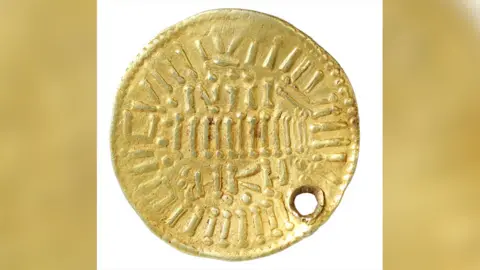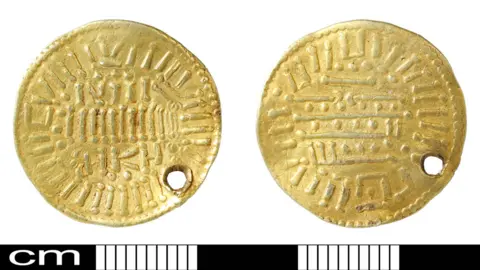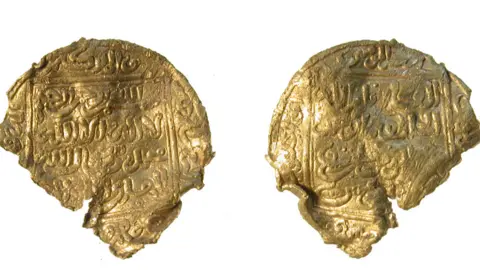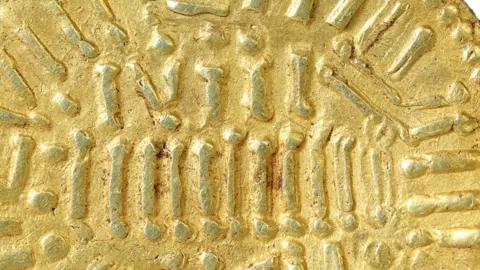Vikings may have made Morston fake gold Arabic dinar, says expert
 Andrew Williams/Norfolk County Council
Andrew Williams/Norfolk County Council A "spectacular" 9th Century fake Arabic dinar discovered by a metal detectorist could have been made by a Viking, a university professor said.
The gold coin was discovered near Morston, Norfolk, in April 2021 and has been declared treasure by a coroner.
Rory Naismith said "the Vikings had a lot of contact with the Muslim world" so it was "plausible" they could have struck imitation dinars.
"It's very unusual to find such a thing and it's completely unique," he added.
 Andrew Williams/Norfolk County Council
Andrew Williams/Norfolk County CouncilThe imitation coin has a hole punched into it suggesting it was designed to be worn.
Prof Naismith, from Cambridge University, said some gold dinars from the Anglo-Saxon period have been found in England, probably arriving via Italy.
"While there are few other imitations that we know of, this one is a bit ropey," he said.
"It looks like it's made by someone who knows the generalities of what a dinar looks like, but is not handling them enough to get the Arabic right."
As a result what should be Arabic script has "degenerated into a series of lines and is completely illegible".
 Suffolk County Council Archaeology ervice
Suffolk County Council Archaeology erviceThe professor of Early Medieval English History said the coin was "most likely" struck in the second half of the 9th Century "and this put it into the period when the Vikings are active".
Contact between the Viking and Muslim worlds has been long-established by historical accounts and many dinars have been found in Scandinavian graves.
"So to my mind there is a very plausible connection" that the coin was a Viking imitation, said Prof Naismith.
However, with no evidence that Arabic traders came to England at this time, he believes the coin was struck in Scandinavia before being lost in Norfolk.
The county was part of the wider area of England ruled under Scandinavian law and customs, known as the Danelaw, which was established following Anglo-Saxon king Alfred the Great's AD878 defeat of the Viking Great Army.
The Vikings had made Thetford in Norfolk one of its winter camps.
Prof Naismith said: "The coin is a spectacular find and I hope it's acquired by a museum."
 Andrew Williams/Norfolk County Council
Andrew Williams/Norfolk County Council
Find BBC News: East of England on Facebook, Instagram and Twitter. If you have a story suggestion email [email protected]
